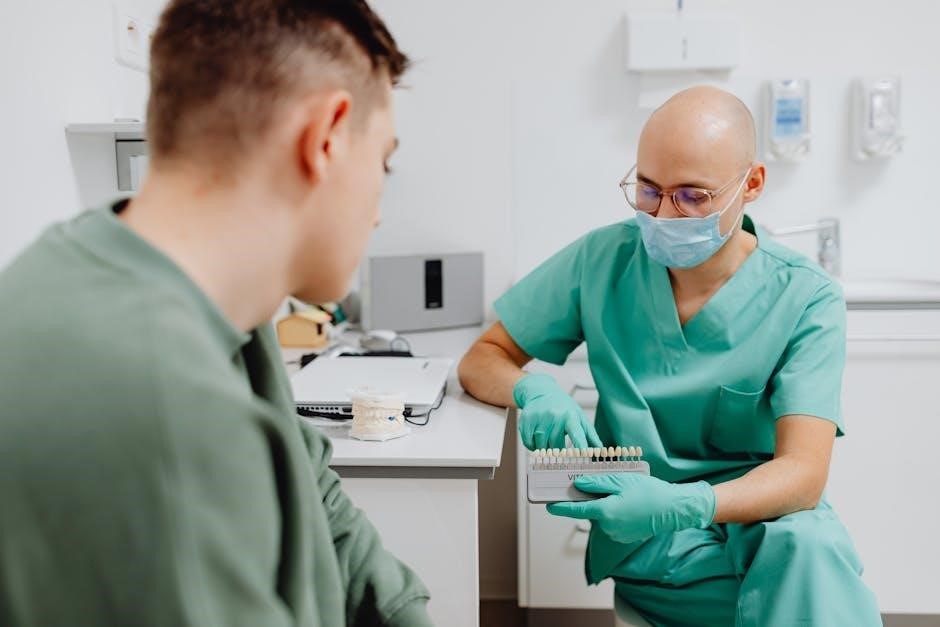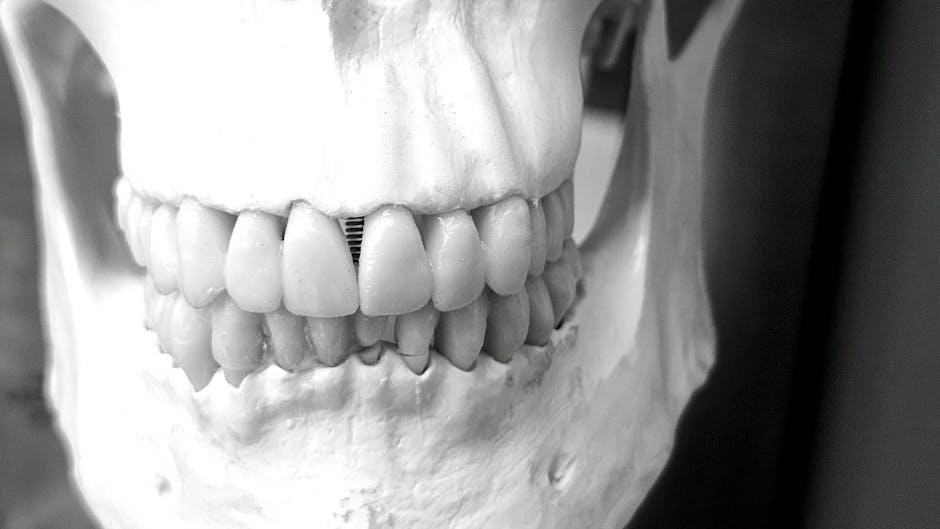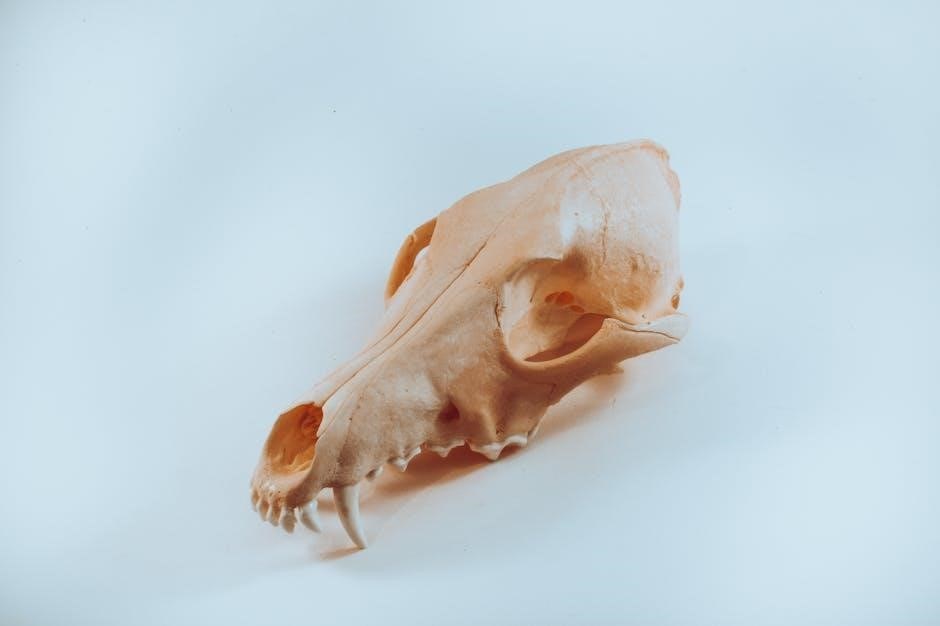Guided Bone Regeneration (GBR) is a surgical procedure to address bone loss, facilitating dental implant placement. It uses biocompatible membranes to promote osseous growth in deficient areas, enhancing implant stability and aesthetics.
1.1 Definition and Purpose of GBR in Dental Procedures
Guided Bone Regeneration (GBR) is a surgical technique that uses biocompatible barriers to direct bone growth in deficient areas. Its primary purpose is to enhance bone density and volume, enabling successful dental implant placement. GBR is essential for addressing bone loss due to trauma, infection, or resorption, ensuring adequate support for implants. By preventing soft tissue infiltration, GBR promotes osseous regeneration, restoring functional and aesthetic outcomes for patients. It is a cornerstone in modern implantology, bridging the gap between bone deficiency and optimal implant placement.
1.2 Historical Context and Evolution of GBR Techniques
The concept of Guided Bone Regeneration (GBR) emerged in the 1950s, with early experiments using metal barriers. The 1980s saw the introduction of non-resorbable titanium meshes. Resorbable materials, like collagen and synthetic polymers, became popular in the 1990s, offering improved biocompatibility. Modern GBR incorporates advanced membranes and biologics, enhancing predictability and minimizing complications. This evolution reflects ongoing research and technological advancements, making GBR a reliable and versatile procedure in contemporary implantology.

CDT Codes for Guided Bone Regeneration
CDT codes for GBR include D4266, D4267, D7953, and D6103, each addressing specific procedures like resorbable barriers, bone grafts, and ridge preservation in implant-related cases.
2.1 Overview of Current Dental Terminology (CDT) Codes
Current Dental Terminology (CDT) codes provide standardized descriptions for dental procedures, ensuring accurate billing and insurance claims. Codes like D4266 and D4267 specifically address guided tissue regeneration, distinguishing between resorbable and non-resorbable barriers. Additionally, D7953 and D6103 cover bone grafting for ridge preservation and peri-implant defects. These codes help dental professionals classify procedures precisely, ensuring compliance with ADA guidelines and facilitating proper reimbursement for bone regeneration and implant-related surgeries.
2.2 Key CDT Codes for Bone Graft Membranes
Key CDT codes for bone graft membranes include D4266 and D4267, which differentiate between resorbable and non-resorbable barriers. D4266 is used for resorbable barriers in guided tissue regeneration, while D4267 applies to non-resorbable ones. Additionally, D7951 is specific to sinus augmentation via a lateral open approach, and D6103 addresses bone grafts for peri-implant defects. These codes ensure precise documentation of membrane usage in bone regeneration procedures, aiding in accurate billing and compliance with dental coding standards.
2.3 Specific Codes for Guided Tissue Regeneration (GTR)
Specific CDT codes for Guided Tissue Regeneration (GTR) include D4266 and D4267, distinguishing between resorbable and non-resorbable barriers. D4266 is used for resorbable barriers, while D4267 applies to non-resorbable ones. Additionally, D3432 is utilized for GTR procedures in conjunction with periradicular surgery. These codes ensure precise documentation of barrier types and their applications, aiding in accurate billing and compliance with dental coding standards for periodontal and implant-related regeneration procedures.

Clinical Applications of Guided Bone Regeneration
Guided Bone Regeneration (GBR) is widely used in implant-related bone grafting, ridge preservation post-extraction, and periodontal tissue regeneration. These applications restore bone volume for optimal dental implant placement and aesthetics.
3.1 Implant-Related Bone Grafting and Peri-Implant Defects
Implant-related bone grafting addresses deficiencies around dental implants, ensuring sufficient bone volume for stability. Peri-implant defects, such as bone loss due to peri-implantitis, are treated with guided bone regeneration. CDT codes like D6103 and D6104 are used for grafting during implant placement or debridement. These procedures restore bone structure, preventing implant failure and enhancing long-term outcomes. GBR techniques promote osseous regeneration, making them critical for successful implant integration in compromised sites.
3.2 Ridge Preservation Post-Extraction
Ridge preservation post-extraction involves maintaining the alveolar ridge’s dimensions after tooth removal to prevent resorption. Bone replacement grafts and membranes are placed to preserve bone volume, ensuring optimal conditions for future implants. CDT code D7953 specifically addresses this procedure, focusing on maintaining bone levels post-extraction. This technique is vital for aesthetic and functional outcomes, as it prevents bone loss and facilitates successful implant placement in the future.
3.3 Periodontal Tissue Regeneration and Osseous Defects
Periodontal tissue regeneration targets the repair of damaged periodontal structures, including bone and ligaments, often due to periodontal disease. Guided bone regeneration is used to address osseous defects, promoting new bone growth. CDT codes like D4266 and D4267 are utilized for resorbable and non-resorbable barriers, respectively, to facilitate tissue regeneration. These procedures exclude epithelial tissue, allowing specialized cells to regenerate bone and periodontal ligaments, correcting defects and restoring tooth support.

Materials and Membranes Used in GBR
Guided bone regeneration employs resorbable and non-resorbable membranes, such as collagen or titanium, to direct bone growth. Autogenous and synthetic graft materials, like bone substitutes, are commonly used.
4.1 Resorbable vs. Non-Resorbable Membranes
Resorbable membranes, such as collagen or polylactic acid, naturally degrade over time, eliminating the need for removal. Non-resorbable membranes, like titanium or PTFE, provide long-term stability but require surgical retrieval. Resorbable options reduce patient discomfort and complications, while non-resorbable membranes offer superior durability for complex defects. The choice depends on defect size, healing time, and patient-specific needs, ensuring optimal bone regeneration outcomes in dental implant procedures.
4.2 Autogenous and Synthetic Bone Graft Materials
Autogenous bone grafts, harvested from the patient’s own body, offer superior osteoconductivity, osteogenicity, and compatibility. Synthetic grafts, made from materials like calcium phosphate or hydroxyapatite, provide a cost-effective, off-the-shelf alternative without donor site morbidity. Both options are widely used in GBR procedures, with autogenous grafts considered the gold standard for bone regeneration due to their biological properties. Synthetic materials, however, eliminate the need for additional surgery, making them a convenient choice for many clinical applications.
4.3 Biologic Materials for Osseous Regeneration
Biologic materials, such as growth factors and platelet-derived products, enhance osseous regeneration by stimulating cellular activity. These materials, often combined with bone grafts, promote osteogenesis and accelerate healing. Examples include recombinant human platelet-derived growth factor (rhPDGF) and collagen-based matrices, which support angiogenesis and bone matrix formation. Their use in GBR procedures optimizes bone regeneration, particularly in complex defects, ensuring better integration of dental implants. Biologic materials are increasingly favored for their ability to enhance predictability and reduce healing times in challenging clinical scenarios.

Surgical Techniques and Procedures
GBR involves placing biocompatible membranes over bone defects to guide regeneration. Techniques include sinus augmentation, ridge preservation, and using resorbable barriers to promote osseous growth for implants.
5.1 Guided Tissue Regeneration (GTR) with Resorbable Barriers
Guided Tissue Regeneration (GTR) with resorbable barriers is a minimally invasive technique to regenerate lost periodontal structures. Resorbable membranes, such as collagen or synthetic materials, are placed over bone defects to exclude epithelial tissue, allowing bone and ligament regeneration; These barriers degrade naturally, eliminating the need for removal. CDT codes like D4266 and D3432 are used for reporting GTR procedures, ensuring accurate billing for resorbable barrier placements. This method is highly effective for treating periodontal defects and preparing sites for dental implants, promoting predictable osseous regeneration.
5.2 Bone Replacement Grafts for Ridge Preservation
Bone replacement grafts for ridge preservation are critical after tooth extraction to maintain alveolar bone volume, ensuring optimal implant placement. These grafts use autogenous, allograft, or synthetic materials, often combined with resorbable barriers. CDT code D7953 is specifically used for ridge preservation, covering bone replacement grafts. Proper documentation and coding ensure accurate billing, while the procedure prevents bone resorption, maintaining facial aesthetics and functional outcomes. This technique is essential for long-term implant success and patient satisfaction, addressing both immediate and future restorative needs.
5.3 Sinus Augmentation and Lateral Open Approach Techniques
Sinus augmentation via the lateral open approach is performed to enhance the maxillary bone height for implant placement in deficient areas. This procedure involves accessing the sinus cavity through the jawbone to place bone grafts or substitutes. CDT code D7951 specifically applies to this technique, describing the augmentation of the sinus to increase alveolar height. Proper documentation ensures accurate billing and compliance with ADA guidelines, while the procedure itself restores the necessary bone structure for successful implant integration and long-term stability.

Coding Guidelines and Best Practices
Accurate coding ensures proper billing and compliance, with specific CDT codes like D4266 and D7951 used for bone grafts and sinus augmentations, adhering to ADA guidelines and avoiding errors.
6.1 Proper Documentation for Graft Procedures
Proper documentation for graft procedures is critical for accurate billing and insurance reimbursement. Codes like D4266 and D7951 require detailed records of graft material, technique, and site-specific details. Documentation must clarify whether the graft material is included or acquired separately, as some codes specify this. Consistent adherence to ADA guidelines ensures compliance and avoids disputes. Accurate descriptions of procedures, such as resorbable barriers or sinus augmentations, are essential. Maintaining clear, detailed records helps prevent coding errors and supports optimal patient care outcomes.
6.2 Avoiding Common Coding Errors in GBR
Avoiding coding errors in GBR requires attention to detail. Common mistakes include misusing codes like D4266 for both resorbable and non-resorbable barriers or incorrectly coding sinus augmentations as D7951 without specifying the approach. Mixing graft materials without additional codes, such as D4265, can lead to underreporting. Ensure each procedure is accurately described, as some codes exclude certain steps like flap entry. Regular updates on CDT codes and ADA guidelines are essential to prevent errors and ensure compliance, optimizing reimbursement and patient care outcomes.
6.3 Compliance with ADA Guidelines for CDT Codes
Compliance with ADA guidelines ensures accurate and ethical coding for GBR procedures. Verify that codes like D4266 and D7953 are used correctly, reflecting the specific techniques and materials involved. Stay updated on annual CDT code revisions to avoid outdated or invalid codes. Proper documentation of each procedure is crucial, as ADA guidelines emphasize precise reporting. Adherence to these standards not only prevents billing errors but also maintains trust and integrity in patient care, ensuring seamless reimbursement and regulatory compliance.
Case Studies and Clinical Outcomes
Case studies highlight successful GBR procedures using codes like D4266 and D7953, demonstrating improved implant placement and bone regeneration. Long-term outcomes show enhanced patient satisfaction and stability.
7.1 Successful GBR Procedures for Implant Placement
Guided Bone Regeneration (GBR) procedures have demonstrated high success rates in preparing deficient alveolar ridges for dental implants. Codes like D4266 and D6103 are commonly used to document these procedures, ensuring accurate billing and insurance reimbursement. Clinical outcomes show significant bone regeneration, enabling stable implant placement. The use of resorbable barriers and bone graft materials has been particularly effective in achieving desired results. Long-term follow-ups indicate improved bone density and successful osseointegration, highlighting GBR’s role in restoring functional and aesthetic outcomes for patients with severe bone loss.
7.2 Long-Term Results of Guided Bone Regeneration
Long-term studies reveal that Guided Bone Regeneration (GBR) yields durable bone growth and stable implant outcomes. Procedures coded under D4266 and D7953 show sustained bone regeneration over decades. Patients exhibit improved bone density and successful osseointegration, reducing the risk of implant failure. These results underscore GBR’s efficacy in addressing complex bone deficiencies, providing a reliable solution for long-term dental restoration and patient satisfaction.
7.3 Complications and Risks Associated with GBR
Complications of GBR include membrane exposure, infection, and graft failure. Smoking, poor blood supply, and systemic diseases increase risks. Proper wound closure and patient compliance are critical. Infection control and meticulous surgical technique minimize these issues. Long-term risks involve implant instability due to incomplete regeneration. Coding accurately reflects these challenges, ensuring proper documentation for complications. Regular follow-ups and adherence to ADA guidelines help mitigate risks, optimizing patient outcomes and procedural success.

Future Trends in Guided Bone Regeneration
Future trends include advanced membrane technology, bioactive materials, and 3D printing for customized grafts, enhancing predictability and patient outcomes in dental implantology and bone regeneration.
8.1 Advances in Membrane Technology and Biologic Materials
Recent advancements in membrane technology have introduced more biocompatible and resorbable materials, reducing the need for second surgeries. Biologic materials, such as growth factors (e.g., rhBMP-2) and collagen-based grafts, enhance osseous regeneration. These innovations improve healing predictability and integration with host tissues. Researchers are also exploring 3D-printed membranes tailored to defect anatomy, offering customized solutions for complex cases. Such progress aims to optimize bone regeneration outcomes, minimizing complications and accelerating patient recovery in dental implantology and reconstructive procedures.
8.2 Integration of Digital Dentistry in GBR Procedures
Digital dentistry is revolutionizing guided bone regeneration by enhancing precision and customization. Advanced technologies like CAD/CAM and 3D printing enable the creation of patient-specific membranes and grafts. Cone beam CT (CBCT) scans provide detailed imaging for accurate defect assessment and surgical planning. Virtual surgical planning allows clinicians to simulate procedures, optimizing outcomes. These tools improve the predictability of bone regeneration, reducing surgical time and complications. The integration of digital solutions is reshaping GBR, offering tailored approaches for complex cases and improving patient care.
8.3 Emerging Research in Osseous Tissue Regeneration
Emerging research focuses on advancing osseous regeneration through innovative materials and techniques. Biocompatible scaffolds, stem cell therapies, and growth factors are being explored to enhance bone healing. Studies on bioactive membranes and nanotechnology aim to improve GBR outcomes. Researchers are also investigating the role of vitamin D in bone regeneration. These advancements hold promise for minimizing invasive procedures and accelerating healing, offering new possibilities for patients with complex bone deficiencies.
GBR is crucial for modern implantology, ensuring optimal patient outcomes. Accurate coding and compliance with ADA guidelines are essential for proper billing and successful procedures.
9;1 Importance of Accurate Coding for GBR Procedures
Accurate coding is critical for GBR procedures to ensure proper billing, reimbursement, and compliance with dental standards. Correct use of CDT codes like D4266 and D7953 prevents errors, delays, or audits. Proper documentation of graft materials and procedures ensures clarity for insurers and patients. Staying updated with ADA guidelines and code revisions is essential to avoid coding mistakes and optimize patient care outcomes.
9.2 The Role of GBR in Modern Dental Implantology
GBR plays a pivotal role in modern dental implantology by addressing bone deficiencies, enabling successful implant placement. It enhances osseous support, improving implant stability and long-term success. Techniques like sinus augmentation and ridge preservation ensure optimal bone volume, making GBR indispensable for complex cases. This procedure bridges the gap between bone loss and functional restoration, offering durable solutions for patients seeking reliable dental implants.
9.3 Final Thoughts on Optimizing Patient Outcomes
Optimizing patient outcomes in GBR requires precise planning, adherence to CDT coding guidelines, and meticulous execution. Proper documentation ensures accurate billing and compliance, while advanced materials and techniques enhance bone regeneration. Patient-specific approaches, combining resorbable membranes with autogenous grafts, yield superior results. Regular follow-ups and tailored care maximize implant success, emphasizing the importance of GBR in achieving functional and aesthetic dental restoration.